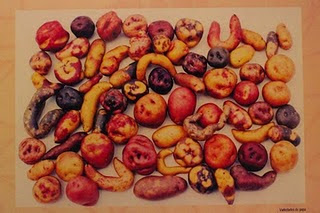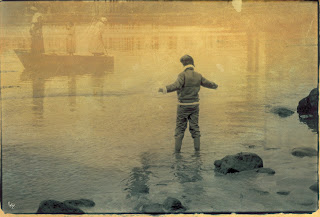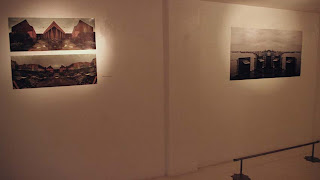
BOTANICAL GARDEN OF THE MUNICIPALITY OF STAVROUPOLI
PHOTOGRAPHY CENTER OF THESSALONIKI
International Photography Contest
“Plant biodiversity - the art of nature”
The Botanical Garden of the Municipality of Stavroupoli and the Photography Center of Thessaloniki, aiming at contributing, informing and highlighting the problem of the loss of biodiversity, announce the third international photography contest on the subject: “Plant biodiversity – the art of nature”. The United Nations has designated 2010 the International Year of Biodiversity. We invite photographers to grasp the chance and implicate creatively their art with the international agony for the environment.
The term biodiversity means the total of live organisms in the ground (biological genders and species), the variety among their relations (ecosystems), and the pictures (landscapes) that man has for the natural environment, as well. Biodiversity refers to 4 levels that constitute an entity.
The first level is that of genetic biodiversity, that is to say the breadth of the hereditary origins (gene – chromosome) of a particular kind.
The second level is that of biodiversity of species of flora and fauna. Τhat is to say the total of individuals of common origin with the same morphological traits (plant kingdom – sum – class – order – family – genus - species – subspecies – variety – form – clone) e.g. Species: citrus limon – lemon tree, citrus sinensis – orange tree, citrus aurantium - sour orange tree etc.
The third level known as biodiversity of ecosystems (habitats) is expressed with the crowd of combinations of plants and animals’ species that is met in a concrete region.
The fourth level is that of biodiversity of landscapes, which is expressed with the crowd of types of landscapes (abiotic and biotic elements) that is presented in a region or in a country.
Biodiversity is today tried intensely because of the multiple pressures that accepts from human interventions and climatic change. The loss of biodiversity hides important dangers for the quality of life and the economic growth. The problem must be pointed out and measures must be taken from governments, societies and each one separately.
In these frames and with emphasis in the Greek plant biodiversity, professional or amateur photographers are called to impress with their personal glance and to attribute with each possible way the subject. The competition is open in photographic aspects that can begin from traditional (classic) photograph and reach up to modern, conjectural, manufactured or digital. Restrictions of technical, chromatic or other interventions in the photographs are not raised by the organizational committee.
Terms of the contest
● Participation in the contest is free. Any professional or amateur photographer may submit photographs, with no discrimination whatsoever.
● Any interested individual may enter the contest with a portfolio, single photographs or a series of photographs.
● All images should be submitted (by post or in person) only at the following address:
Botanical Garden of Stavroupoli
Pericleous 9A Stavroupoli 56431 Thessaloniki, Greece
To the attention of: Photography Contest
● Submission deadline: 15-07-2010 (postmark)
● The jury panel shall consist of three members: one representative of the Stavroupoli Municipality, one accomplished photographer of Photography Center of Thessaloniki , and Mr. Yannis Tsalikidis, Professor of Landscape Architecture, Faculty of Agronomy, Aristotle University of Thessaloniki.
● The judgement of the jury panel shall be final. No objection or other claim shall be accepted.
● Each photograph must be printed on paper size of at least 20×25 cm, ready for presentation, and for the needs of the catalogue in digital form with 22cm the big side and analysis 300 dpi. At the back of each photograph (even if it is part of a series) the following information should be written: title of the photograph (if any); location where the photograph was taken; the photographer’s full name, address, phone number and e-mail address (if any).
Languages: Greek, English, German.
● The submitted material shall not be returned.
● The images to be selected by the jury panel shall become the main part of a large photography exhibition to be initially presented at the exhibition premises of the Stavroupoli Municipality, and subsequently in other locations inside and outside Greece.
● The first exhibition of the photographs shall begin at 15st September 2010.
● The expenses for the exhibition of the images (in Stavroupoli as well as in the other locations inside and outside Greece) shall be borne by the organizer.
● At least 60 of the prize-winning photographs of the exhibition shall be included in a luxurious catalogue / album, which shall be sent to all prize-winning photographers.
● 15 of the photographs shall be included in a 2011 calendar to be published by the Botanical Garden of the Stavroupoli Municipality.
● Additional prizes shall be announced very shortly. The prizes shall be awarded at a special ceremony.
● The contest results shall be announced on the Internet and made known to all participants (www.stavroupoli.gr και www.fkth.gr).
● The copyright of the catalogue and calendar belongs to the Botanical Garden of Stavroupoli. The copyright of the individual photographs belongs to the respective photographers.
● All works may be used to publicize the contest and its goals in any medium and in any manner. The contest participants are not entitled to any remuneration whatsoever.
For further informations the concerned can adress by email to botanic.gard@stavroupoli.gr
● Participation in the contest means the unconditional acceptance of all terms referred to above.
Aim of the photographic contest is to point out the plant biodiversity, the biodiversity of ecosystems, the biodiversity of landscapes, so as more citizens and administrations take knowledge about the issue, become more sensitized and mistakes in the management of nature’s diversity to be corrected. The way all these will be bond with the art of photography and will be imputed originatively is up to the photographers.
FEW WORDS ABOUT BIODIVERSITY
In our planet exist an inconceivable number of beings. Nowadays, however a lot of factors threaten biodiversity. The downgrading, the breaking to pieces and the destruction of biotopes, the unsustainable activities, the overexploitation of soil, forests, lakes and oceans, the pollution of water, soil and atmosphere, the intensive agriculture, the excavations, the reconstruction and the invasion of foreign conquering species are some of the elements that damage biodiversity.
Biodiversity in Greece
Greece disposes a big variety of animals, plants, mushrooms, algae, micro-organisms and ecosystems, one of the largest in Europe. Found in the crossroad of three continents, with varied geomorphology and big climatic breadth, but also with particularly long-lasting history of coexistence of human with nature, Greece has acquired a remarkable biodiversity with special plant and animal forms, enough from which can not be met nowhere elsewhere in the world.
It is calculated that exist about 6.300 taxa (species and subspecies) of plants from which above 700 are endemic. The variety of vegetation, of flora and fauna, is also reflected in the big variety of presented ecosystems, from semideserted Vai palm forest in Crete up to the cold betula, pinus and abies forests. This diversity of ecosystems is also presented in a small relatively surface. In distance of 150 km from Kavala to central Rodopi, man can cross all types of the mediterranean, middle-europe and north-scandinavian bands of flora. However, even if we dispose rich biodiversity, we don not protect her and we have not appreciated her value either as state or as society.
The value of biodiversity
The maintenance of biodiversity has big importance for the humanity and for all forms of life. Among the values of maintenance of biodiversity are included:
The socio-economic values by the profits that result from the use of biodiversity, particularly for the elimination of poverty worldwide.
The medico-pharmaceutical values by the biological substances on which are based almost all the therapeutic methods.
The aesthetic and cultural values that cover the deeper needs of human.
The ecological values that are related with the survival and the normal function of most ecosystems which contribute in the maintenance of the environmental conditions of our planet.
It is therefore realized that biodiversity decreases worldwide and that the rhythm of the disappearance of species grows more than never, with simultaneous reduction of the extent of their biotopes. This loss has as a result the downgrading of services and goods that ecosystems provide, while the ability of plant societies to support the future generations is jeopardized as well.
The biodiversity is threatened today by the rapid changes that human provoked in our planet. The way and the intensity man uses the natural resources create multiple threats against environment, such as the disappearance of species, the modification and downgrading of biotopes and the general exhaustion of natural resources. Therefore, it is our responsibility to protect biodiversity.
BOTANICAL GARDEN OF STAVROUPOLI PHOTOGRAPHY CENTER OF THESSALONIKI
GERMANBOTANISCHER GARTEN DER STADTGEMEINDE VON STAVROUPOLI
FOTOZENTRUM VON THESSALONIKI
Internationaler Fotowettbewerb
" Pflanzen- Biologische Vielfalt - die Kunst der Natur"
Der botanische Garten der Stadtgemeinde von Stavroupoli und das Fotozentrum von Thessaloniki, um des Problems dem Verlust der biologische Vielfalt beizutragen, köndigen den dritten internationalen Fotographie Wettbewerb auf dem Thema: " Pflanzen-– die kunst der Natur". Die Vereinten Nationen haben 2010 das internationale Jahr von Biologischer Vielfalt gekennzeichnet.
Der Term Biologische Vielfalt bedeutet die Gesamtheit der Beleb-Organismen in der Erde (biologische Gene und Sorte), die Vielfalt unter ihren Relationen (Ökosystemen), und die Abbildungen (Landschaften), das Mann für die natürliche Umwelt hat. Die biologische Vielfalt bezieht sich auf 4 Ebenen, die einen einzigen Satz sind.
Die erste Ebene ist die genetischer Vielfalt, nämlich die Breite der erblichen Wurzeln (Gene und Chromosomen) einer bestimmten Sorte.
Die zweite Ebene ist die biologische Vielfalt der Sorte, der Flora und der Fauna. Nämlich die Gesamtheit den Atomen der allgemeinen Ursprung mit dem gleichen morphologischen Merkmale (Pflanzenreich – Summe – Klasse – Ordnung – Familie – Genre –Sorte – Untersorte – Vielfalt – Form – Klon), zum Beispiel, Sorte Citrus limon – Zitronenbaum, Citrus sinensis Orangenbaum, Citrus aurantium – Sevilla Orangen.
Die dritte Ebene, als die biologische Vielfalt von Ökosystemen bekannt ist, wird mit der Masse von Kombinationen der Pflanzen und der Tiere Sorten ausgedrückt, der in einer konkreten Region getroffen wird.
Die vierte Ebene ist die biologische Vielfalt von Landschaften, der mit der Masse der Arten der Landschaften ausgedrückt wird (Biotischen und Abiotischen Elemente), das in einer Region oder in einem Land dargestellt wird.
Die biologische Vielfalt wird heute intensiv wegen des mehrfachen Drucks versucht, der von den menschlichen Interventionen und von der klimatischen Änderung annimmt. Der Verlust der biologische Vielfalt versteckt wichtige Gefahren für die Lebensqualität und das Wirtschaftswachstum. Das Problem muss unterstrichen werden und Maßnahmen von den Regierungen, von den Gesellschaften und jeder von separat ergriffen werden müssen.
In diesen Rahmen und mit Hauptgewicht im griechischen biologische Vielfalt, werden Fachmann oder Bewundererphotographen, um mit ihrem persönlichen flüchtigen Blick zu beeindrucken angerufen und mit jeder möglichen Weise das Thema zuzuschreiben. Die Konkurrenz ist in den fotographischen Aspekten geöffnet, die von der traditionellen (klassischen) Fotographie anfangen und bis modernem, abbildendem, hergestelltem oder zu digitalem erreichen können. Beschränkungen der technischen, chromatischen oder anderen Interventionen in den Fotographien werden nicht vom organisatorischen Ausschuss gesetzt.
Teilnahmebedinungen
Die Teilnahme am Wettbewerb ist kostenlos. Sowohl professionelle Fotografen als auch Laien können ohne jeglichen Unterschied Fotos einsenden.
Die Interessenten nehmen mit einem Portfolio, einzelnen Fotos oder Fotoserien am Wettbewerb Teil.
Die Werke sind ausschließlich an die folgende Adresse zu schicken oder dort abzugeben:
Botanischer Garten von Stavroupoli
Perikleous 9A Stravroupoli 56431
Thessaloniki - Griechenland
Mit dem Hinweis, dass sie für den Fotowettbewerb bestimmt sind.
Die Einreichungsfrist für Fotos ist der 15.07.2010 (es gilt das Datum des Poststempels).
Die Jury setzt sich aus drei Mitgliedern zusammen und wird vom Stellvertretenden Bürgermeister von Stavroupoli, einem renommierten Fotografen und dem Professor für Landschaftsarchitektur der Landwirtschaftlichen Fakultät der Aristoteles-Universität Thessaloniki, Herrn Tsalikidis Iannis, gebildet.
Die Entscheidung der Jury ist endgültig, Einsprüche oder sonstige Klagen sind unzulässig.
Alle Fotos sind auf Papier gedruckt und mit einer Abmessung von mindestens 20 x 25cm einzusenden und zu den Notwendigkeiten des Kataloges in der digitalen Form mit 22cm, das große Seite und Analyse 300 dpa. Auf der Rückseite eines jeden Fotos (auch wenn, es als Teil einer Serie eingeschickt wird) sind der Titel (sofern vorhanden), der Ort der Aufnahme des Fotos, Vor- und Zuname des Fotografen, vollständige Anschrift, Telefon und E-Mail (sofern vorhanden) anzugeben. Zulässige Sprachen: Griechisch, Englisch und Deutsch.
Das eingeschickte Material wird nicht zurückgeschickt.
Die von der Jury ausgewählten Werke bilden die Grundlage einer großen Fotoausstellung, die zunächst im Ausstellungsraum der Gemeine Stavroupoli gezeigt wird und anschließend in Griechenland und im Ausland zu sehen sein wird.
Die erste Einweihung wird am 15st September 2010 stattfinden.
Die Kosten für die Aufhängung und Präsentation der Werke in der Ausstellung übernimmt der Organisator. Das gleiche gilt auch für die anschließende Wanderausstellung.
Mindestens 60 der prämierten Fotos der Ausstellung werden in einen luxuriösen Katalog / Fotoband aufgenommen, der allen prämierten Fotografen kostenlos zugesandt wird.
15 der Fotos werden in einen Kalender aufgenommen, der vom Botanischen Garten der Gemeinde Stavroupoli für das Jahr 2011 herausgegeben wird.
Weitere Preise werden in einer gesonderten Mitteilung bekannt gegeben. Diese Preise werden auf einer speziellen Festveranstaltung verliehen.
Die Ergebnisse des Wettbewerbs werden im Internet veröffentlicht und allen Teilnehmern mitgeteilt. ( www. stavroupoli. gr und www. fkth. gr)
Das geistige Eigentumsrecht am Katalog und am Kalender hat der Botanische Garten von Stavroupoli. Die geistigen Eigentumsrechte an den Fotos haben die Fotografen.
Die Werke können für ihre weitere Veröffentlichung im Rahmen des Wettbewerbs und seiner Ziele in jedem beliebigen Medium und auf jegliche Art und Weise verwendet werden, ohne dass daraus ein Anspruch auf ein Honorar des Teilnehmers entsteht.
Mit seiner Teilnahme am Wettbewerb erklärt der Teilnehmer die vorbehaltslose Anerkennung der vorstehenden Bedingungen.
Das Ziel der fotographischen Konkurrenz ist die pflanzen - biologische Vielfalt, die biologische Vielfalt von Ökosystemen, die biologische Vielfalt von Landschaften unterstreichen werden, besonders unseres Landes, damit mehr Auskunft und Leitungen nehmen wissen, die Menschen mehr sensibilisiert werden und Fehler im Management der Natur korrigiert werden.
BOTANISCHER GARTEN DER STADTGEMEINDE VON STAVROUPOLI
FOTOZENTRUM VON THESSALONIKI





























